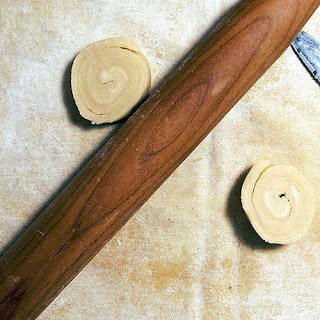This particular sambal is very similar to tempeh kering. The final steps are the same, the only difference is the ingredients. While tempe is almost as cheap as potatoes in Indonesia, unless you make your own tempe in the US, you'll find this version is much cheaper with potatoes than with tempe. You could also make this with kettle style potato chips; I'd suggest using the unsalted variety. If you don't like your food looking back at you, you can eliminate the ikan teri (anchovies). They provide an interesting crunch and flavor, but your sambal will be no less authentic without them.
Wandering Chopsticks, whose blog was one of the first to make me aware of food blogs and inspired me to start this blog, recently posted about enjoying this sambal at a food court in Southern California. In her post she mentioned she wanted to learn how to make it, so here it is as a small token of my appreciation for her assistance over the years. While most Indonesians might enjoy this with rice, it is an excellent accompaniment to beer or cocktails.
Sambal Goreng Kering
printable recipe
6--8 potatoes (about 2 lbs.), peeled, julienned or thinly sliced with a mandoline
14 oz peanuts (if raw, fry in oil for five to six minutes until cooked)
60 -- 120 grams ikan teri, dried anchovies
oil for frying
2 TBS oil
3--4 shallots, about 60 grams, peeled and minced
2 cloves garlic, peeled and minced
3 fresh red chilies, stemmed, seeded, and chopped
6--9 TBS gula jawa (palm sugar)
2 TBS tamarind pulp dissolved in 3/4 cup water
3 daun salam (if you can't find them, leave them out)
4 slices fresh (or frozen) galangal
1 tsp salt
In batches, first fry the potatoes several minutes in oil around 300º F. Drain and let cool. Heat the oil to 375º and fry the potatoes a second time until crisp, about two minutes more. It's important that the potatoes be very crisp before you put them in the sauce. Drain on paper towels.
You also have to fry the ikan teri in oil. Once you have done so, you will not want to use this oil for anything else. So, you may want to pour off and reserve some of the oil used to fry the potatoes before frying the anchovies. These should be fried around 350º F for just a minute or two. Drain on paper towels.
With a food processor or mortar and pestle, process or grind the shallots, garlic, and chilies to a paste. Stir fry the paste in the 2 TBS of oil until softened and fragrant. Add 6 TBS of palm sugar and stir until melted. Add in the tamarind water, daun salam, galangal, and salt. Stir and cook over medium heat until this becomes the consistency of a thick syrup. Taste and adjust sweetness to your preference. Fold in the potatoes, peanuts and ikan teri until all are covered with and have absorbed the sauce. If your potatoes were crisp, the sambal should remain crisp in an airtight container for several days.









